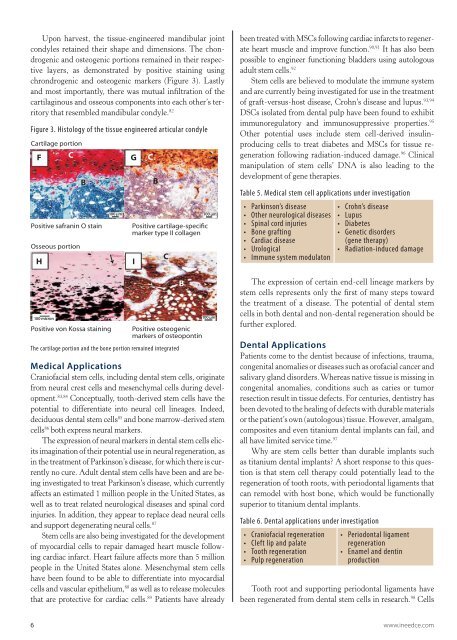Stem Cells: Sources, Therapies and the Dental ... - IneedCE.com
Stem Cells: Sources, Therapies and the Dental ... - IneedCE.com
Stem Cells: Sources, Therapies and the Dental ... - IneedCE.com
Create successful ePaper yourself
Turn your PDF publications into a flip-book with our unique Google optimized e-Paper software.
Upon harvest, <strong>the</strong> tissue-engineered m<strong>and</strong>ibular joint<br />
condyles retained <strong>the</strong>ir shape <strong>and</strong> dimensions. The chondrogenic<br />
<strong>and</strong> osteogenic portions remained in <strong>the</strong>ir respective<br />
layers, as demonstrated by positive staining using<br />
chrondrogenic <strong>and</strong> osteogenic markers (Figure 3). Lastly<br />
<strong>and</strong> most importantly, <strong>the</strong>re was mutual infiltration of <strong>the</strong><br />
cartilaginous <strong>and</strong> osseous <strong>com</strong>ponents into each o<strong>the</strong>r’s territory<br />
that resembled m<strong>and</strong>ibular condyle. 82<br />
Figure 3. Histology of <strong>the</strong> tissue engineered articular condyle<br />
Cartilage portion<br />
F C<br />
Positive safranin O stain<br />
Osseous portion<br />
H<br />
100 micron<br />
B<br />
Positive von Kossa staining<br />
100 µm<br />
G<br />
C<br />
B<br />
Positive cartilage-specific<br />
marker type II collagen<br />
I<br />
C<br />
B<br />
Positive osteogenic<br />
markers of osteopontin<br />
The cartilage portion <strong>and</strong> <strong>the</strong> bone portion remained integrated<br />
100 µm<br />
100 µm<br />
Medical Applications<br />
Craniofacial stem cells, including dental stem cells, originate<br />
from neural crest cells <strong>and</strong> mesenchymal cells during development.<br />
83,84 Conceptually, tooth-derived stem cells have <strong>the</strong><br />
potential to differentiate into neural cell lineages. Indeed,<br />
deciduous dental stem cells 85 <strong>and</strong> bone marrow-derived stem<br />
cells 86 both express neural markers.<br />
The expression of neural markers in dental stem cells elicits<br />
imagination of <strong>the</strong>ir potential use in neural regeneration, as<br />
in <strong>the</strong> treatment of Parkinson’s disease, for which <strong>the</strong>re is currently<br />
no cure. Adult dental stem cells have been <strong>and</strong> are being<br />
investigated to treat Parkinson’s disease, which currently<br />
affects an estimated 1 million people in <strong>the</strong> United States, as<br />
well as to treat related neurological diseases <strong>and</strong> spinal cord<br />
injuries. In addition, <strong>the</strong>y appear to replace dead neural cells<br />
<strong>and</strong> support degenerating neural cells. 87<br />
<strong>Stem</strong> cells are also being investigated for <strong>the</strong> development<br />
of myocardial cells to repair damaged heart muscle following<br />
cardiac infarct. Heart failure affects more than 5 million<br />
people in <strong>the</strong> United States alone. Mesenchymal stem cells<br />
have been found to be able to differentiate into myocardial<br />
cells <strong>and</strong> vascular epi<strong>the</strong>lium, 88 as well as to release molecules<br />
that are protective for cardiac cells. 89 Patients have already<br />
been treated with MSCs following cardiac infarcts to regenerate<br />
heart muscle <strong>and</strong> improve function. 90,91 It has also been<br />
possible to engineer functioning bladders using autologous<br />
adult stem cells. 92<br />
<strong>Stem</strong> cells are believed to modulate <strong>the</strong> immune system<br />
<strong>and</strong> are currently being investigated for use in <strong>the</strong> treatment<br />
of graft-versus-host disease, Crohn’s disease <strong>and</strong> lupus. 93,94<br />
DSCs isolated from dental pulp have been found to exhibit<br />
immunoregulatory <strong>and</strong> immunosuppressive properties. 95<br />
O<strong>the</strong>r potential uses include stem cell-derived insulinproducing<br />
cells to treat diabetes <strong>and</strong> MSCs for tissue regeneration<br />
following radiation-induced damage. 96 Clinical<br />
manipulation of stem cells’ DNA is also leading to <strong>the</strong><br />
development of gene <strong>the</strong>rapies.<br />
Table 5. Medical stem cell applications under investigation<br />
• Parkinson’s disease<br />
• O<strong>the</strong>r neurological diseases<br />
• Spinal cord injuries<br />
• Bone grafting<br />
• Cardiac disease<br />
• Urological<br />
• Immune system modulaton<br />
• Crohn’s disease<br />
• Lupus<br />
• Diabetes<br />
• Genetic disorders<br />
(gene <strong>the</strong>rapy)<br />
• Radiation-induced damage<br />
The expression of certain end-cell lineage markers by<br />
stem cells represents only <strong>the</strong> first of many steps toward<br />
<strong>the</strong> treatment of a disease. The potential of dental stem<br />
cells in both dental <strong>and</strong> non-dental regeneration should be<br />
fur<strong>the</strong>r explored.<br />
<strong>Dental</strong> Applications<br />
Patients <strong>com</strong>e to <strong>the</strong> dentist because of infections, trauma,<br />
congenital anomalies or diseases such as orofacial cancer <strong>and</strong><br />
salivary gl<strong>and</strong> disorders. Whereas native tissue is missing in<br />
congenital anomalies, conditions such as caries or tumor<br />
resection result in tissue defects. For centuries, dentistry has<br />
been devoted to <strong>the</strong> healing of defects with durable materials<br />
or <strong>the</strong> patient’s own (autologous) tissue. However, amalgam,<br />
<strong>com</strong>posites <strong>and</strong> even titanium dental implants can fail, <strong>and</strong><br />
all have limited service time. 97<br />
Why are stem cells better than durable implants such<br />
as titanium dental implants? A short response to this question<br />
is that stem cell <strong>the</strong>rapy could potentially lead to <strong>the</strong><br />
regeneration of tooth roots, with periodontal ligaments that<br />
can remodel with host bone, which would be functionally<br />
superior to titanium dental implants.<br />
Table 6. <strong>Dental</strong> applications under investigation<br />
• Craniofacial regeneration<br />
• Cleft lip <strong>and</strong> palate<br />
• Tooth regeneration<br />
• Pulp regeneration<br />
• Periodontal ligament<br />
regeneration<br />
• Enamel <strong>and</strong> dentin<br />
production<br />
Tooth root <strong>and</strong> supporting periodontal ligaments have<br />
been regenerated from dental stem cells in research. 98 <strong>Cells</strong><br />
6 www.ineedce.<strong>com</strong>

















